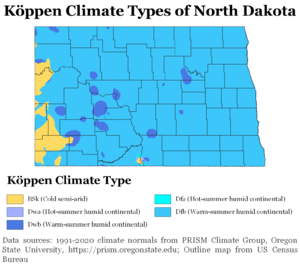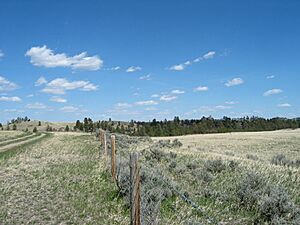Climate of North Dakota facts for kids

North Dakota has a continental climate, which means it has very cold winters and warm to hot summers. Because it's in the Upper Midwest, North Dakota sees many different types of weather throughout the year. Each of its four seasons has its own special features. The eastern part of the state has a humid continental climate, meaning it has warm, somewhat humid summers and cold, windy winters. The western part has a semi-arid climate, which means it gets less rain and is less humid, but still has similar temperatures. Areas east of the Missouri River tend to have slightly colder winters. West of the river, summer daytime temperatures are often higher. The difference between day and night temperatures is usually bigger in the west because it's higher up and less humid.
Contents
North Dakota's Weather Basics
North Dakota is in the middle of North America. This means it has very extreme temperatures, with super cold winters and very hot summers. The weather patterns can be quite surprising! For example, a storm called an Alberta clipper often happens in winter. But because the weather can be so unpredictable, this type of storm could also happen in spring or late autumn. Hot weather usually happens in July and August, but it can sometimes start as early as April or May. It can even last into September or October.
North Dakota is about 1,000 miles (1,600 km) from any big ocean or lake. This is why its temperatures and rainfall can change a lot. The state is far enough north to have temperatures as low as −60 °F (−51 °C) and huge snowstorms in winter. But it's also far enough south to reach 121 °F (49 °C) and have many tornadoes in summer. The difference between North Dakota's highest and lowest temperatures is a massive 181 °F (100 °C). This is the third largest difference of any U.S. state!
North Dakota is not close to major sources of moisture. It's in a zone where the wet eastern U.S. meets the drier western U.S. This means that rainfall and humidity decrease as you go from east to west. The average yearly rainfall across the state ranges from about 14 inches (35.6 cm) in the west to 22 inches (55.9 cm) in the east. Snow is the main type of precipitation from November through March. Rain is more common during the rest of the year. It has even snowed in North Dakota during every month except August!
North Dakota's Seasons
North Dakota experiences four distinct seasons, each bringing its own unique weather.
Winter Weather
Winter in North Dakota is known for its very cold temperatures, which are usually below freezing. Snow is the main type of precipitation. However, freezing rain, ice, sleet, and even regular rain can happen during winter. Common storm systems include "Alberta clippers" (fast-moving storms from Canada) or "Panhandle hooks" (storms that form in the southern U.S. and move north). Some of these storms can turn into full-blown blizzards. The average yearly snowfall ranges from 26 inches (66 cm) in the central part of the state to 38 inches (96.5 cm) in the northeast and southwest. Temperatures as low as −60 °F (−51 °C) have been recorded during North Dakota winters.
Spring Weather
Spring is a time of big changes in North Dakota. Early spring often brings snowstorms. But by late spring, as temperatures get warmer, the state can experience tornado outbreaks. This risk continues through summer and into fall, as North Dakota is at the northern edge of Tornado Alley. Springtime flooding is common in the Red River Valley. This happens because the river flows north into Canada. The snowmelt and runoff usually start earlier in the southern part of the valley than in the northern part. The worst flooding in eastern North Dakota happened in 1997, causing a lot of damage to Grand Forks.
Summer Weather
Summer brings heat and humidity to the east. In the west, conditions are generally hotter and less humid. These humid conditions help create thunderstorms, which happen 22 to 34 days a year. Summer high temperatures in North Dakota average in the mid-80s °F (around 30 °C) in the west. In the east, they average in the upper 70s °F (around 25 °C). Temperatures as hot as 121 °F (49 °C) are possible. The growing season for crops usually starts in April, and harvest begins in September and October. Tornadoes can happen in North Dakota from April through October. However, July is the peak month for tornadoes, followed by June and August. The state averages 13 tornadoes per year.
Autumn Weather
Autumn weather in North Dakota is largely the opposite of spring weather. The jet stream, which usually weakens in summer, starts to get stronger again. This leads to faster changes in weather patterns and more varied temperatures. By late October and November, these storm systems become strong enough to form major winter storms. Fall and spring are the windiest times of the year in North Dakota.
Extreme Weather Events
North Dakota has seen some truly extreme weather events throughout its history.
Recent Droughts
In September 2017, the entire state experienced unusually dry weather. This was a severe and sudden drought, sometimes called a "flash drought." It happened because of long periods of high temperatures and very little rain, which quickly dried out the soil. This drought caused an estimated $4 billion to $5 billion in economic losses for the state's agriculture. Another severe drought happened from 1988 to 1992. The "Great Drought" of the 1930s was also very tough. Nine out of eleven years from 1929 to 1939 had less than average rainfall.
Major Floods
The year 2011 saw widespread flooding across North Dakota. The U.S. Geological Survey recorded 22 record high river levels statewide that year. The 1997 Red River flood was a huge flood that happened in April and May 1997. It affected the Red River of the North in Minnesota, North Dakota, and southern Manitoba, Canada. It was the worst flood on that river since 1826.
Historic Blizzards
A major blizzard hit North Dakota from April 4-7, 1997. It brought heavy snowfall, up to 2 feet (60 cm) in some areas, and winds up to 65 mph (105 km/h). This caused widespread power outages and stranded many drivers. Sadly, about 100,000 cattle, or 10% of the state's herd, died. Damages were nearly $45 million. This storm helped Bismarck set an all-time seasonal snowfall record of 101.4 inches (257.5 cm), which still stands today.
One of the most severe blizzards on record happened from March 2-5, 1966. This storm was memorable because it lasted so long. It brought very heavy snowfall, with 20 to 30 inches (50-75 cm) in some places, and wind gusts over 70 mph (110 km/h). Snowfall totals reached as high as 38 inches (96.5 cm), and snow drifts were 30 to 40 feet (9-12 meters) high!
The winter of 1996-1997 also saw record snowfall. By the end of November 1996, Fargo had already received over 26 inches (66 cm) of snow. By the end of December, the season total was over 46 inches (117 cm). Three official blizzards hit in January alone. By the time the last snowflake fell in April, Fargo had a total of 117 inches (297 cm) of snow for the year!
Extreme Cold and Heat
The winter of 1935-1936 was the coldest on record for North Dakota. February 1936 was the coldest February ever recorded in the connected U.S., and the coldest month ever in North Dakota.
In contrast, the summer of 1936 was the warmest nationwide since 1895. North Dakota set its all-time record high temperature of 121 °F (49 °C) in Steele on July 6. Bismarck recorded a low temperature of only 83 °F (28 °C) on July 11, meaning it stayed incredibly hot even at night.
Another dangerously cold period hit North Dakota in February 1996. The town of Rolette reported a morning low of −53 °F (−47 °C). Many places saw lows from −35 °F to −45 °F (−37 °C to −43 °C). Fargo tied its record low of −39 °F (−39 °C). The temperature in Fargo stayed at or below zero for 11 straight days. Northwest winds up to 30 mph (48 km/h) made the wind chill feel like −100 °F (−73 °C)!
February 2019 was also extremely cold. The state's average temperature for February was −2.9 °F (−19.4 °C). This made it the second coldest February in 125 years, and the coldest since 1936.


